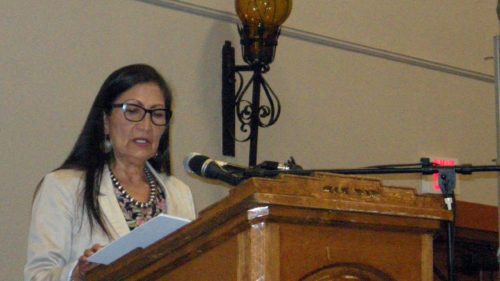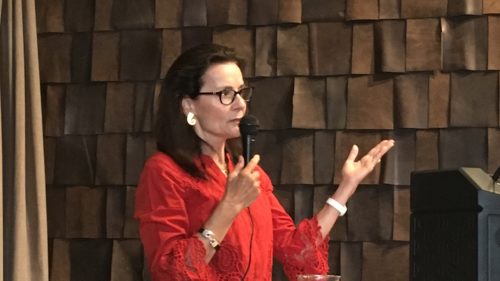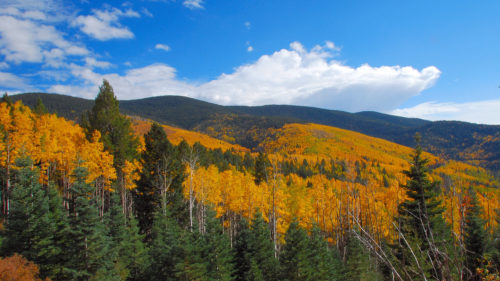By Ben Neary
NMWF Conservation Director
ALBUQUERQUE — Norm Gaume, former director of the New Mexico Interstate Stream Commission, has devoted years to fighting a pending proposal to take water from the Gila River for irrigation. He’s giving a public talk about what’s wrong with the project and why now’s the time to pull the plug.
Gaume will speak on the Gila diversion project as part of the New Mexico Wildlife Federation’s monthly lecture series. The free talk starts at 5:30 p.m. Wed., July 10, at Marble Brewery’s Northeast Heights location at 9904 Montgomery Blvd., NE, in Albuquerque.
Gaume has cherished the Gila River for decades. “Boating that river, which I started doing when I was in my early 30s, was a life-changing experience for me,” he said. “It’s just a very, very special place.”
Gaume noted that the river flows out of the Gila Wilderness, the nation’s first wilderness area. It was set aside on the recommendation of pioneering conservationist Aldo Leopold, who also founded the New Mexico Wildlife Federation.
“They set aside the Gila Wilderness and the headwaters because it’s a very special place, and to allow people, our descendants, to experience wilderness travel,” Gaume said.
While Gaume opposes the Gila project, he’s hardly against water projects in general. He served as director of the New Mexico Interstate Stream Commission, which has responsibility for developing the state’s water supply, from 1997 until 2002. Before that, he was water resources manager for the City of Albuquerque. He’s now retired.
“I’ve worked on water development projects a good part of my career,” Gaume said. “This project is stupid, it makes no sense particularly on the Gila River. And it makes no sense from an engineering perspective.”
Gaume said he began digging into the project in 2013 and was appalled to see that the diversion plan the Interstate Stream Commission was pursuing at the time was impossible. He commented at the time that the version of the project then under consideration would produce little to no water and be hugely expensive.
“It couldn’t be done,” Gaume said. “So this has kind of turned into a good government and basic honesty issue for me. The proponents are not telling the truth. Some of them are not competent to understand that, others are.”
In response to a complaint from Gaume, the New Mexico Attorney General’s Office concluded in 2016 that the entity the Interstate Stream Commission established to pursue the Gila project had violated the state’s Open Meetings Act by making substantial decisions about the project behind closed doors. He’s filed a series of other complaints about the project as well.
The current Gila project is the latest in a series of proposals dating back to the 1960s to dam, divert or otherwise squeeze water from the river before it flows out of the southwestern corner of New Mexico into Arizona. Earlier projects were scrapped because studies concluded that they would be too expensive, that there was no real need for the water and that the environmental effects on the Gila, one of the last free-flowing rivers in the West, would be too great.
Congress in 2004 gave New Mexico the option to accept federal funding to meet regional water needs across four counties in the southwestern corner of the state or to hold out for a larger pot of money to build a diversion project on the Gila. The Interstate Stream Commission in 2014 opted for the diversion project.
The commission created an entity, called the New Mexico Central Arizona Project Entity, to handle the planning effort. Over $15 million has been spent on planning so far but Gaume and other critics say there’s little to show for it.
The current plan calls for diverting water from two locations on the Gila River and from one location on the San Francisco River, a Gila tributary. However, the U.S. Bureau of Reclamation, the federal agency handling environmental review of the project, has expressed concerns about whether the project planning can meet looming federal deadlines.
Gov. Michelle Lujan Grisham, who took office this year, campaigned on opposing the project. She vetoed some planning money for the project earlier this year and has said she wants the remaining project money, about $75 million, spent on other water supply projects in southwestern New Mexico. Nonetheless, the Interstate Stream Commission voted recently to continue project planning, using nearly $1 million in leftover money that had been allocated last year.
Proposals over the last 50 years to take water out of the Gila River all stem from New Mexico congressmen pushing to get the largest possible slice of federal funding, Gaume said.
“One of the reasons that this project has never made sense is that it didn’t rise up, so to speak, based on its own merits,” Gaume said. “Rather, it was the result of political horse-trading in the United States Senate.”
Former New Mexico Senator Clinton P. Anderson demanded that legislation authorizing the Central Arizona Project that moved through Congress in the 1960s also contain language that authorized work in New Mexico, Guame said.
All the water on the Gila River had been spoken for since about 1900. Nonetheless, Congress specified that New Mexico could take more water from the river and replace it downstream in Arizona with water from the Central Arizona Project.
“It hadn’t been evaluated from an engineering perspective but it was politically authorized,” Gaume said. “Now the (U.S. Bureau of Reclamation) finds themselves in the unusual position to have a congressional authorization for a project that’s not been defined. It changes their perspective.”
Although federal studies have concluded that past water diversion plans on the Gila didn’t make financial sense and would involve considerable environmental harm, Gaume said project supporters remained unfazed.
“They believe that any water that New Mexico has should be developed,” Gaume said. “It’s basically kind of a water development religion. It doesn’t make sense, but it’s more an article of faith, more than it is an article of need, or feasibility or anything practical.”
Gaume said the Interstate Stream Commission funded an Environmental Impact Statement in 2016. “But it took two years for them to come up with even a sketch of an idea of what they wanted and basically their original ideas all had failed too,” he said.
“One of the telling criticisms is that after spending $15 million on so-called planning, they don’t have a feasibility study, they have never contracted for a feasibility study or any kind of a benefit-cost analysis,” Gaume said.
The federal Bureau of Reclamation recently announced that it can’t finish the project’s environmental impact statement until mid-2020. Gaume said he’s reviewed an internal review draft of the document. He said the report concludes that providing water from the diversions is going to cost $3 million a year, twice what the resulting crops would sell for, to say nothing of covering the expense of growing them in the first place.
There’s a requirement in federal law that new water projects have to make economic sense. But because Congress already has authorized the Gila project, Gaume said it’s unclear how that requirement would apply. He said he suspects project supporters expect the federal government will forgive the cost of the project so irrigators who benefit from it wouldn’t have to pay for it.
Gaume said diverting water from the Gila would have bad environmental consequences. “First of all, the Gila River has pretty much a natural ecosystem, because it’s still highly variable, it flashes, the river spills, it creates new channels,” he said. “This creates the habitat that endangered species evolved in and rely on. And it would mess that up.”
Stopping work on the Gila project now would free up about $75 million in federal funding that could be used on other water supply projects in the four counties of southwestern New Mexico, Gaume said. “There are good ways to develop water and provide it to most of the people in the area that would give them water security for, I believe, centuries,” he said.
“I think what the public needs to do is to ask Michelle Lujan Grisham to follow through on her campaign commitment and end work on the diversion, now,” Gaume said. “Not waste another million on the environmental impact statement.”



